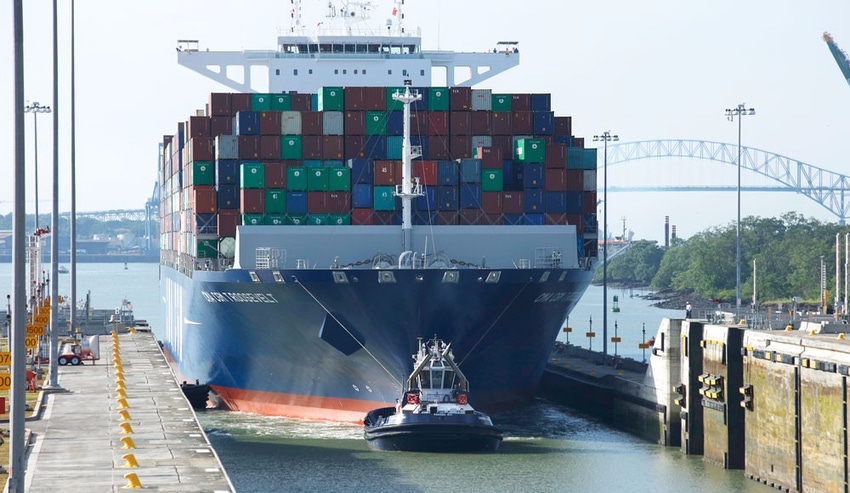Expanded lock has not yet received grain containership.
August 23, 2017

The Panama Canal this week welcomed the CMA CGM Theodore Roosevelt, the largest-capacity vessel to ever transit the expanded locks. The Neopanamax containership, which began its voyage from Asia, will be making stops along the U.S. East Coast.
The CMA CGM Theodore Roosevelt has a total 20 ft. equivalent unit (TEU) allowance of 14,855 and measures 365.9 m in length and 48.2 m in beam. To put the scale of this enormous ship into perspective, its length is roughly the equivalent of laying end to end two of the Great Pyramids of Giza, four of Big Ben or eight of the Statue of Liberty.
“Today’s transit not only represents the growing success and adoption of the expanded canal but also its impact on reshaping world trade,” Panama Canal administrator Jorge Quijano said.
The CMA CGM Theodore Roosevelt is deployed on the new OCEAN Alliance’s weekly South Atlantic Express service, which connects Asia with U.S. East Coast ports via the Panama Canal. The express service is comprised of 11 vessels ranging in size from 11,000 to 14,000 TEUs, including vessels that also transited the expanded canal earlier in May, becoming the largest-capacity ships to do so at the time.
The CMA CGM Theodore Roosevelt began its voyage in Shanghai, China, and will soon call on ports along the East Coast, including in Norfolk, Va.; Savannah, Ga., and Charleston, S.C., all of which have seen strong growth and record-breaking tonnage following investments made to accommodate the larger vessels now able to transit the expanded canal. For this voyage, the vessel will also call on the Port of New York & New Jersey, which recently completed a four-year, $1.6 billion project to raise the Bayonne Bridge to 215 ft. The move will allow the nation’s third-largest port, for the first time, to accept ships larger than 9,500 TEU to reach three of its four main terminals.
In addition to the vessel’s record-breaking capacity, what’s notable about the transit of the CMA CGM Theodore Roosevelt is that it also highlights the Panama Canal’s ability to reduce carbon dioxide emissions compared to alternative routes. By traveling through Panama, the vessel saved 29,561 tons of carbon dioxide by bypassing the Cape of Good Hope.
Emission reductions have been a key focus of the expanded canal, which celebrated its one-year anniversary in June. In its first year of operation, the expanded canal contributed to the reduction of 17 million tons of carbon dioxide, thanks to the shorter traveling distance and larger cargo carrying capacity it offers customers.
Looking ahead to the 2018 fiscal year, which begins on Oct. 1, the Panama Canal Authority is projected to accommodate approximately 13,000 vessels, including 2,335 Neopanamax vessels, for a record tonnage of 429.4 million Panama Canal tons.
Ken Eriksen, senior vice president head of client advisory and development and energy and transportation services at Informa Economics IEG, told attendees at the 2017 Commodity & Feed Ingredients Outlook Symposium being held in Minneapolis, Minn., this week that the expanded locks have yet to receive a grain vessel.
You May Also Like

.png?width=300&auto=webp&quality=80&disable=upscale)

